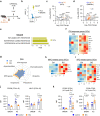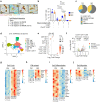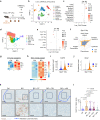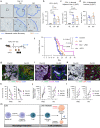Kupffer cells prevent pancreatic ductal adenocarcinoma metastasis to the liver in mice
- PMID: 37816712
- PMCID: PMC10564762
- DOI: 10.1038/s41467-023-41771-z
Kupffer cells prevent pancreatic ductal adenocarcinoma metastasis to the liver in mice
Abstract
Although macrophages contribute to cancer cell dissemination, immune evasion, and metastatic outgrowth, they have also been reported to coordinate tumor-specific immune responses. We therefore hypothesized that macrophage polarization could be modulated therapeutically to prevent metastasis. Here, we show that macrophages respond to β-glucan (odetiglucan) treatment by inhibiting liver metastasis. β-glucan activated liver-resident macrophages (Kupffer cells), suppressed cancer cell proliferation, and invoked productive T cell-mediated responses against liver metastasis in pancreatic cancer mouse models. Although excluded from metastatic lesions, Kupffer cells were critical for the anti-metastatic activity of β-glucan, which also required T cells. Furthermore, β-glucan drove T cell activation and macrophage re-polarization in liver metastases in mice and humans and sensitized metastatic lesions to anti-PD1 therapy. These findings demonstrate the significance of macrophage function in metastasis and identify Kupffer cells as a potential therapeutic target against pancreatic cancer metastasis to the liver.
© 2023. Springer Nature Limited.
Conflict of interest statement
G.L.B. reports prior or active roles as a consultant/advisory board member for Boehinger Ingelheim, Adicet Bio, Aduro Biotech, AstraZeneca, BiolineRx, BioMarin Pharmaceuticals, Boehinger Ingelheim, Bristol-Myers Squibb, Cantargia, Cour Pharmaceuticals, Genmab, HiberCell, HotSpot Therapeutics, Incyte, Janssen, Legend Biotech, Merck, Monopteros, Molecular Partners, Nano Ghosts, Opsona, Pancreatic Cancer Action Network, Seagen, Shattuck Labs, and Verastem, and; reports receiving commercial research grants from Alligator Biosciences, Arcus, Bristol-Myers Squibb, Genmab, Gilead, Halozyme, HiberCell, Incyte, Janssen, Newlink, Novartis, and Verastem,. G.L.B. is an inventor of intellectual property (U.S. patent numbers 10,640,569 and 10,577,417) and recipient of royalties related to CAR T cells that is licensed by the University of Pennsylvania to Novartis and Tmunity Therapeutics. N.B., J.D., B.H. are employees of Hibercell, Inc. M.U. is a previous employee of Hibercell and current employee of OncXerna. N.B., J.D., B.H., M.U. are Hibercell stockholders. N.B., M.U. are an inventors of intellectual property that is licensed to Hibercell. M.U. holds OncXerna and Rigel stock. M.C. is an employee of Merck & Co., Inc and holds Merck stock. M.M.W. reports prior or active roles as a consultant for Nanology. The remaining authors declare no competing interests.
Figures







References
-
- Siegel RL, et al. Cancer statistics, 2022. CA: A Cancer J. Clinicians. 2022;72:7–33. - PubMed
Publication types
MeSH terms
Substances
Grants and funding
LinkOut - more resources
Full Text Sources
Medical
Molecular Biology Databases

